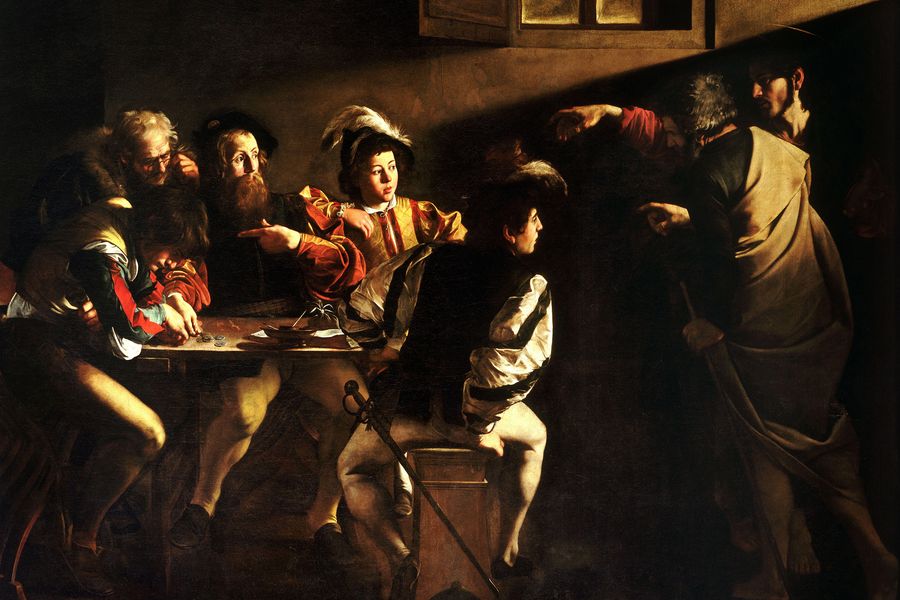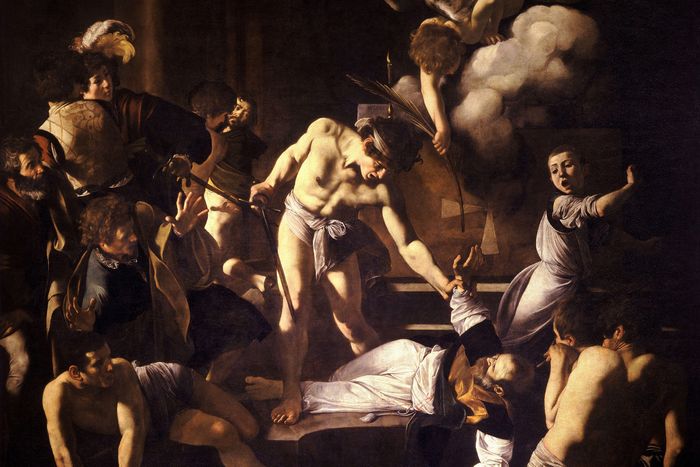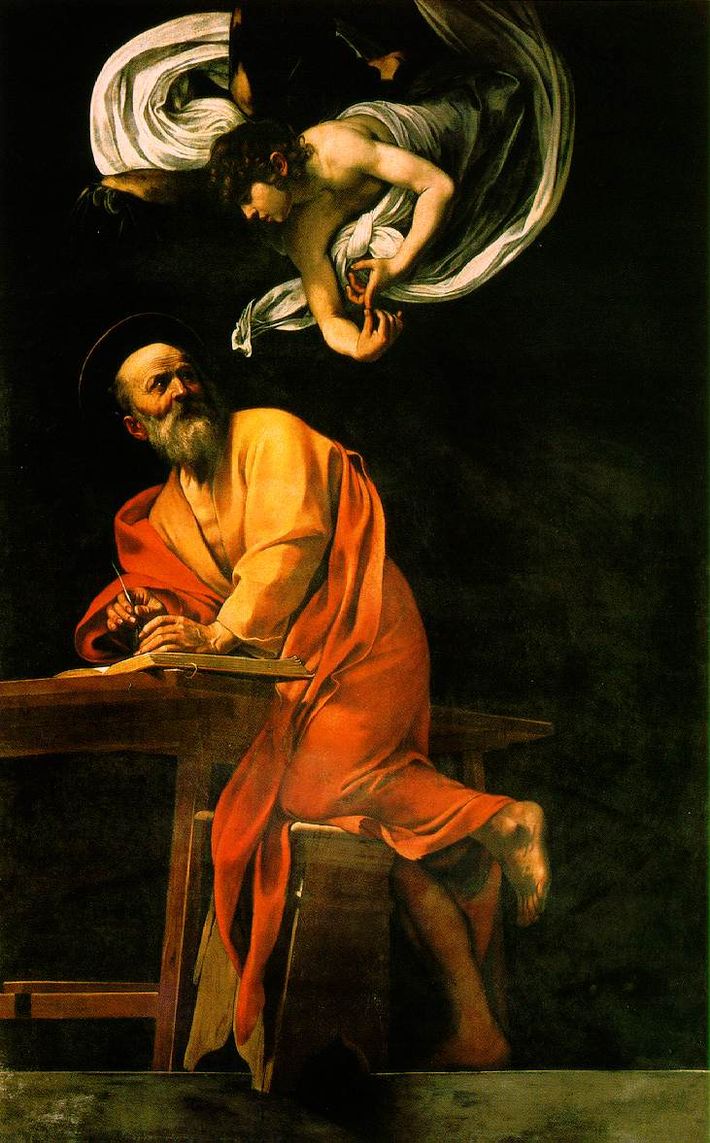Again and again during this pandemic, unable to actually see art in person, I have time-traveled within myself for sustenance — with the help of the internet, of course. Viewing art online flattens the contextual experience: It is just as easy, or just as difficult, to call up a Renaissance masterpiece as a contemporary painting, and each appears on my computer screen in precisely the same way, without any of the trappings of art-historical importance (gilded frames, museum lighting, grand settings) or contemporary novelty (the vacuum-quiet space of a blue-chip gallery, the buzz of hype).
In these sessions of inner priestcraft, I invariably arrive in the past, indeed always the distant past, often the Renaissance. Lately, I’ve been traveling to Rome in 1600, when, at the age of 28, Michelangelo Caravaggio triggered a thermo-nuclear artistic explosion when the first two of his paintings of St. Matthew were installed in a small, newly built chapel in a church. Even then, everyone knew something shocking had happened. Painters were “looking upon his works as miracles,” it was written. Rivals groused that “this monster of genius” had wrought the “end of painting.” Artists had spent the previous 50 years revering Raphael, Leonardo, and Michelangelo, so much that ersatz Renaissance paintings had become a cottage industry among worshipful painters and princes wanting to show they had the same taste as popes and potentates — much like current monkey-see-monkey-do collectors of contemporary art. Yet there were brilliant Mannerists like Pontormo and Bronzino, who were estranged from this type of classicizing but found ways around it by wildly exaggerating certain aspects of Renaissance paintings: elongating necks, fingers, and torsos till bodies became paranormal apparitions to express strained emotions in ethereal spaces. In one fell swoop, Caravaggio shattered Renaissance wholeness, clarity, recessional space, and unity, along with Mannerism’s aristocratic affectations, anxious self-consciousness, and abstruse optical effects. (I adore Mannerism for all of this.) Caravaggio’s work seems to unleash new human forces into art; whirling, corkscrewing space; shafts of light and shadow; theatricality; and, above all, a new, colossal unideal naturalism of painting from life. He creates an almost modern psychological interiority that leads directly to geniuses like Rembrandt and Velázquez (who dispense with theatrics for miracles of sensual inwardness), Vermeer and Bernini, and, in English literature, to John Milton’s lines like “Blood, death, and deathful deeds are in that noise, Ruin, destruction at the utmost point.” All this is why Caravaggio’s follower Nicolas Poussin praised him for coming “into the world to destroy painting.”
Caravaggio would be dead within ten years, but he changed art history. He arrived in Rome in his early 20s, destitute and often in trouble, but was soon taken in by a Medici-family associate. Before his life and career were over, the constant brawler was arrested numerous times, imprisoned, convicted of murder, and sentenced to beheading; he escaped south and never returned to Rome. He may have been murdered himself while trying to get back. Nevertheless, he was, in his few years, a pop-culture superstar loved by the people and controversial among the clergy. Caravaggio’s titanic new style is called Baroque, and it transformed painting, sculpture, architecture, music, literature, fountains, cities, religion — everything. The Baroque feels vital now in the way it refuses to accept a simple world of surfaces, rule-bound theoretical art, and overly thought-out scenes and instead probes deeper into the core of lived experience.
The commission for the Matthew cycle came in July 1599, courtesy of that Medici connection, and paved the way to stardom for the unruly, unconventional painter while allowing this new chapel to take a chance on a new artist. A lot rode on this commission; plus, the pope might even see it. The cycle was painted in a tear — he must have been on fire. The last painting of the story was begun first, The Martyrdom of Saint Matthew. It is the greatest depiction ever made of what Shakespeare, writing concurrently, in Hamlet, calls “murder most foul.” Two large figures center the painting, one of them a twisting, nearly naked young man with a pointed rapier in his right hand. He is standing over and grimacing in fury at an older man who is sprawled on the ground between his legs. He has murdered the old man, running his heart through with the now-withdrawn sword. Blood spurts from the mortal wound. That man is Matthew; this is his martyrdom; he is already dying. The slayer stands in dominion over Matthew the way Muhammad Ali stood over a knocked-out Sonny Liston. This is the exact second before death, an instant of action, and pain, never before or since rendered this realistically, horrifically, or beautifully. We are stunned, hypnotized, repelled, frightened, fascinated, confused, and stupefied by it all. Caravaggio’s realism is so derived from observation that the scene becomes undeniable.
According to some tellings, Matthew was martyred in Ethiopia after saying Mass. This is why he wears vestments here and seems to be on the steps of an altar. People in various states of nakedness suggest baptisms. All the dress is contemporary; the executioner appears to have been painted from life and was perhaps a friend of Caravaggio’s. Predator and prey form this riveting, still center of the pandemonium around them. The geometry is a kind of swirling, chambered-nautilus spiral. There may be 13 figures here, but it’s hard to make them all out; it’s like some pictorial deep-sea vent.
Our eyes search for anything anchored — some place of stability among the chaos. There it is: Above Matthew, visible only to him, is a beautiful, winged angel who twists and bends to offer the palm of martyr-dom to the dying disciple. An altar boy in white robes screams and flees. His right arm mimics Matthew’s; his trunk turns the opposite way of the murderer’s. Caravaggio often echoes, opposes, mirrors, and flip-flops poses. Often someone will face forward next to a figure facing away. In the darkness over the swordsman’s right forearm, we see the artist, large boned, brooding, staring, and intense.
As maximal as the Martyrdom is, the Calling of St. Matthew is minimal. This is the scene where Christ calls Matthew as his disciple. The entire top of this picture is almost empty. That’s radical! Whole areas are just blackness. In a dim room, five figures sit around a table. We know Matthew was a Jewish tax collector. He’s the richly dressed patrician with a coin in his hat; his right hand is near the money pile in front of him. Note his elegant belt. Around him are a man apparently paying his taxes, an associate, and two sword-wielding, thuggish young buccaneers, typical types of Caravaggio’s time, when Rome was overrun with crime, unemployed soldiers, mercenaries, gangs, and local Mafia-like warlords.
Jesus and Peter appear on the right. Jesus raises his hand and arm toward the table. This gesture intentionally echoes Michelangelo’s Sistine-ceiling Adam extending his left hand to be touched by God. This makes sense for an artist saying there’s a new game in town; narratively, Christ is also known as the “the new Adam.” (Challenging Michelangelo so directly took amazing guts and risked offending the taste of any patron insulted by this gesture of pictorial gall.) A beam of light from above Jesus dawns across the room. It shines on Matthew, who instinctively raises his left hand as if to wonder, Who, me? In the Bible, Jesus calls Matthew thusly: “ ‘Follow me’ … And Matthew got up and followed him.” Some say Matthew is gesturing at the man to his right, as if saying, “Who, him?” Yet this man has no idea what’s going on around him and still looks down. Now examine Matthew’s legs and feet. They unconsciously turn toward Jesus. This is Matthew in the act of leaving one life and joining another. Talk about being “called.” Caravaggio is mind-blowing this way.
The final painting in the cycle, the Inspiration of St. Matthew, is Matthew writing his Gospel. He has just arrived at a table — there’s an open book on it waiting for him — and dipped his pen into an inkwell. He’s so taken by something that he hasn’t even sat down and turns on one knee while standing. (The stool is about to fall off the ledge it’s on.) I’ve never seen anyone painted this way before or since. I know this pose in my bones, though. I’ve run to my desk in the grip of imagined inspiration like this, possessed. Matthew isn’t looking at the page. He looks above him at the same seraph we see in the Martyrdom. This angel gestures with his fingers as if counting — one, two, three, this, then that, then the next — as if establishing and clarifying the narrative of the life of Jesus that Matthew is attempting to set down. It is patient angelic aid for an author trying to get this right. In effect, the angel is consoling him, saying, “Okay, Matthew, first comes the Sermon on the Mount, then the loaves and the fishes, then his entry into Jerusalem, then the Last Supper.”
I’ve seen these paintings thrice; each time ranks among the best days of my life. In this, my 188th day of quarantine, largely away from galleries and museums and fixated on the chaos around us, something in these paintings called to me. A mystery of some kind beckons; a skeleton key that wants turning. I can’t stop thinking about that angel showing Matthew how to write, the same one who reaches quietly downward, extending the palm as Matthew’s arm rises upward. This way of rising speaks volumes. But what is it telling us? Then, bam, after ten days, I see it. Amid all the action, observation, and dramatics, a paradoxical deep content opens. It is slowness — the slowness of Matthew wondering, not quite knowing what is happening in any of the paintings; a slowness that makes him me, you, all of us. Humanness.
In the painting of him writing, I see an author at a loss for words to suit the subject, trying, failing, hoping a ghost of inspiration might appear. This is a slowness and desperation that all writers and artists know. The Martyrdom is a man looking away from his killer, knowing another presence is here, not knowing what, coming to terms with something, allowing his hand to reach in wonder toward this otherness he feels above him. None of this comes with a lightning bolt of revelation and is more like the gradual, almost glacial, boreal reckonings I have been feeling these days away from the world yet watching the world lurch in starts. Matthew’s hand doesn’t extend in protest or terror. It extends in a gradual, final acceptance of grace, of knowing something new. In these frozen moments of painting, time eases into some cosmic soup of slow knowing. This lets me finally let go, too. I give up on knowing how Caravaggio created this quelling quietude of balm within clamorous space. Instead, I just savor it.
*This article appears in the September 28, 2020, issue of New York Magazine. Subscribe Now!




